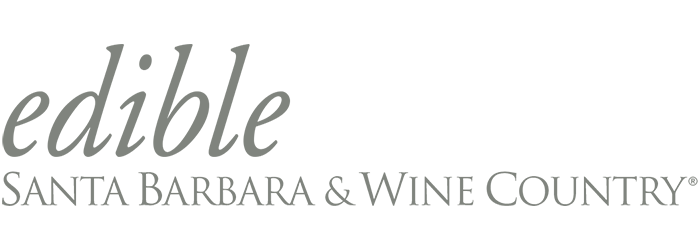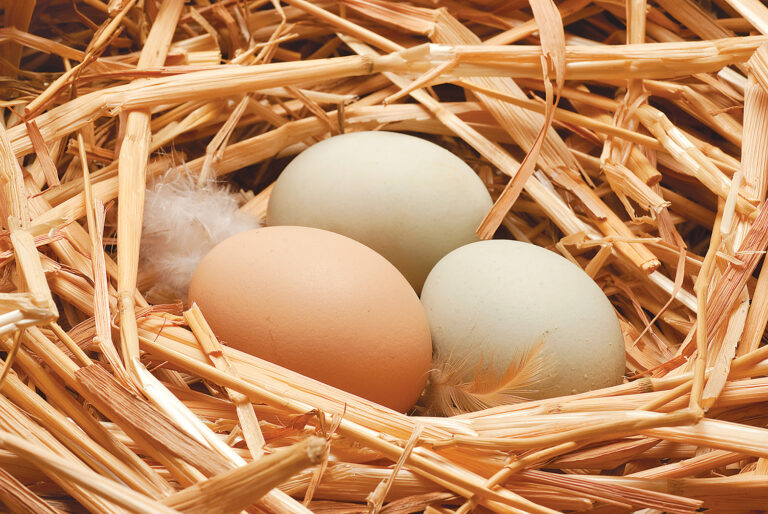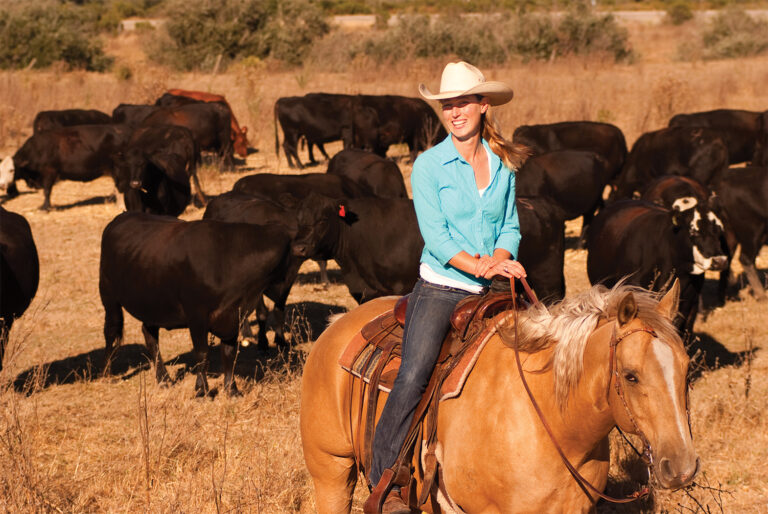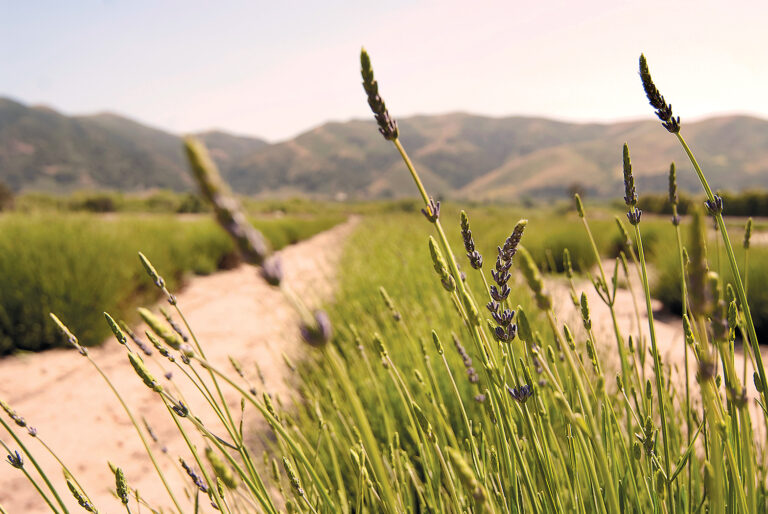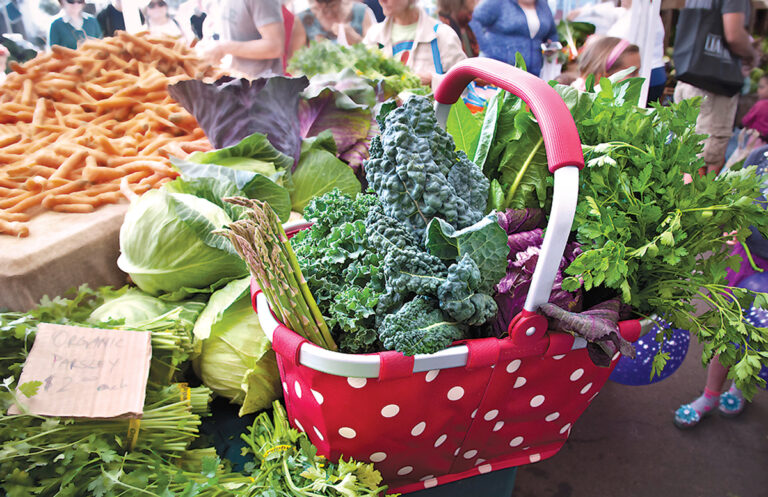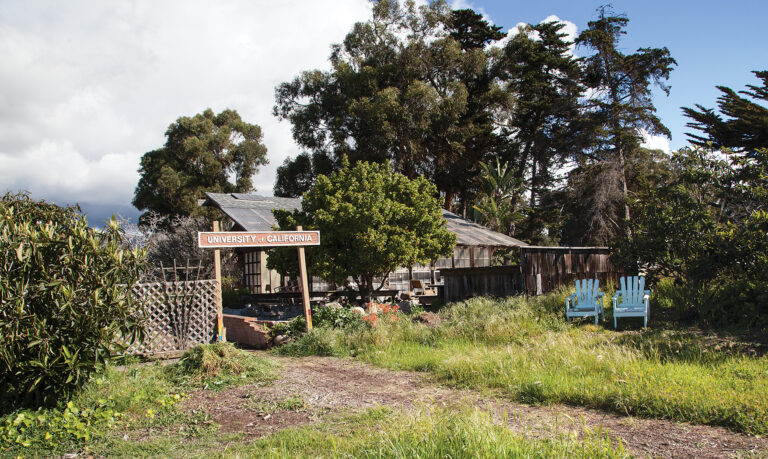Diving for California Gold
[Photography by Fran Collin]
Just off our coast, 20 to 100 feet below the surface, Santa Barbara divers harvest some of the world’s best sea urchins.
I watch as urchin diver Stephanie Mutz rolls backwards off the side of her small boat into the deeper water near Leadbetter Beach to examine a reef she knows well. She is looking for premium sea urchins that contain “California Gold,” the highest-grade uni (bright golden urchin meat).
On this unseasonably warm day in early January, I’m helping onboard while she dives. My reward? The promise of the freshest uni I’ll ever taste. My early experience with sushi bar uni had put it on the list of things I’d never try again, but what I ate had been preserved with alum. Stephanie says fresh uni without the alum has a completely different flavor and texture.
She waves and disappears below the surface. The air hose attached to a small compressor feeds out from the bench next to me as she swims down 25 feet to the reef. A thick forest of giant macrocystis kelp indicates that the urchin on this reef will be well-fed and sweet-tasting.

Consider the Urchin
Urchins were once considered a pest because their voracious appetite for kelp severely affected the kelp harvest. Laminaria and macrocystis kelp grow well here and both have commercial value. There are stories of hammer-wielding urchin-killing parties and statewide programs to eradicate urchins. However, the Japanese market for sea urchin turned that around. With access to proper processing and overnight shipping to markets in Japan in the 1970s, the urchin “gold rush” began.
I sit on top, wondering what it’s like down there. Stephanie is worried about visibility. Recent swells have churned up debris. “Sometimes,” she says, “I hit the ocean floor before I can see it.” Hopefully today isn’t one of those days. It’s smooth on top. The sunlight forms a swath of diamonds that dance on the surface of the ocean. Although the distant water looks deep blue, where we have anchored it’s deep green—an indication of lower visibility. The best urchins are harvested out by the Channel Islands, but equipment problems in the morning have shortened our fishing day. We’re happy to find an accessible reef closer to shore today.
The rhythmic sound of the compressor is broken by the sudden release of the pressure valve regulating the air that allows Stephanie to stay down two or three hours at a stretch. She wears a wrist computer to let her know how deep she is and how much longer she can safely continue raking urchins into the large mesh bag she has taken with her. On a full diving day, she will come to the surface to off-gas nitrogen bubbles and eat her lunch, then go back down for a couple more hours.
Listening for the reassuring sound of the boat motor and hearing the waves lap the sides of the boat, I look for the circle of bubbles rising to the surface that tells me where Stephanie is working. I also see the small head of a sea lion in the distance, waiting and watching, hoping for a handout.
Suddenly Stephanie is at the surface. Eureka! She emerges with a bag of urchins. Back on the boat, she attaches the mesh bag to the winch and pulls it up onto the deck.
She pulls out a large red urchin. The mouth on its underside is the easiest place to crack it. She inserts a tool to break the shell and spreads it open into two halves. She pours out the liquid and cleans out the dark parts, then runs a spoon around the inside to extract five pieces of golden meat (referred to as roe, but actually male or female reproductive tissue which contains the spawn). It’s almost spawning season so the pieces are full and brightly colored. When males and females release their sperm and eggs into the water column, the quality of the meat will decline. But I’m tasting them near their peak.
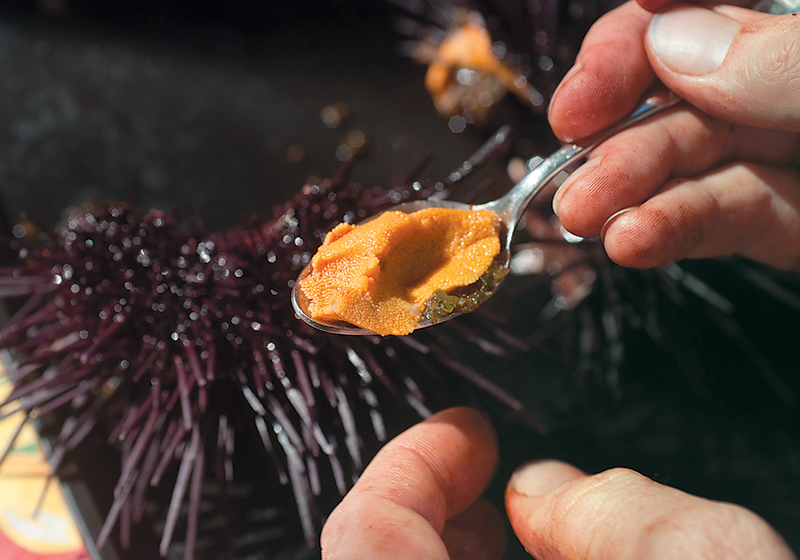
Fresh from the shell, this one is buttery with a hint of nuttiness—no fishiness. This is not like any uni I have ever tasted, and I immediately scratch it off my “never try again” list. Stephanie notes that the meat softens as spawning time approaches. A creamy orange liquid forms around the pieces we’ve removed. That is the female spawn (male spawn is white). Alum stops this oozing, but so does a bit of orange juice. I don’t really mind the creaminess.
We put the remaining urchins into a cooler for the sea urchin pizza dinner we are planning. Fresh live urchin will keep refrigerated in the shell for a day or two.
The Local Market
While local fishermen supply about a third of the 10 to 12 million pounds of California red urchin harvested per year, most of it is shipped elsewhere. Ironically, much of the urchin eaten in Santa Barbara is imported from other ports or has been shipped to Los Angeles or San Diego for alum processing and shipped back here through distributors.
Stephanie is working with other local fishermen to change that by educating consumers about fresh local seafood. On Saturday mornings Stephanie shares a spot with two other fishermen at the Fisherman’s Market at the Harbor Breakwater—just down the walkway from the Santa Barbara Fish Market (a good source for local fish). Stephanie offers tastes of fresh uni during the peak season and other seafood when seasonally available.
At educational events, along with fisherman Steve Escobar, she teaches people how to crack a sea urchin, cook a crab or fillet a fish. She especially enjoys educating restaurant owners and caterers so that her product can be served at its best.
Recently she worked with Jeff Olsson of New West Catering to develop an uni appetizer for a Cambria Estate Winery event. She says, “When I dropped off the urchins to Jeff the day before, I spent an hour or more in his kitchen talking about all things urchin. What Jeff prepared with my urchin was phenomenal. The best way I’ve ever experienced uni—a fried wonton with avocado, a piece of urchin and sea salt. It was crunchy, savory, sweet and salty. A perfect bite.” And Jeff took the time to teach his servers about uni so they could explain the difference between the fresh and processed product. People who had never liked uni loved it—the best way to educate the consumer (recipe on page 34).
Ricci di Mare Pizza
At this point, I no longer needed convincing, but my husband, Dave, hadn’t shared the boat experience with me and sea urchin pizza does seem a bit strange—especially when it starts with a cooler full of spiny marine animals that look like hedgehogs.
When we arrived at Steve Escobar’s house, he was heating up his wood-fired pizza oven. Stephanie had an array of ingredients to try and some fresh pizza dough ready to go. After searching for the rolling pin we opted to roll out the dough with a wine bottle (fishermen are really good at impromptu solutions).
Instead of marinara sauce, Stephanie had mixed crème fraiche with a little cream—just enough to make it easy to spread on the dough. Steve had julienned some roasted beets to resemble red urchin spines. Gruyere cheese complemented the uni flavor better than the mozzarella or ricotta versions we tried. We arranged beet “spines,” sliced shitake mushrooms and urchin pieces on top of the grated cheese. We added red pepper flakes to spice it up. That went into the pizza oven until the crust was crispy and the toppings had caramelized. The final touch was a handful of fresh arugula on top. Yes, it was delicious. The urchin was sweet, creamy and caramelized by the heat.
Community
For Stephanie, the key to protecting our fisheries is community. As president of the Commercial Fishermen of Santa Barbara, she works with other local fishermen to be actively involved in setting standards and regulations that address regional conditions and concerns. One project they are working on is the development of a Santa Barbara Seafood label to let consumers know right away that they are buying local seafood.
Community includes the awareness among local consumers that we have a valuable resource here that deserves protection.
Just Ask
So how do we get access to more of this locally caught fish and shellfish? We ask for it. We let our restaurants, sushi bars and grocery stores know that we want it. We ask our servers which fish on the menu has been caught locally. We buy from markets that sell local fish. We go to the Saturday Fisherman’s Market and farmers markets to get to know our local fishermen and support the work they do to keep our fisheries healthy and productive.
Resources
- To order directly from Stephanie Mutz, go to her website Sea Stephanie Fish.
- Commercial Fishermen of Santa Barbara
- California Sea Urchin Commission
- Bluewater Gold Rush: The Odyssey of a California Sea Urchin Diver by Tom Kendrick. The story of sea urchin diving in Santa Barbara, written by a local diver.
